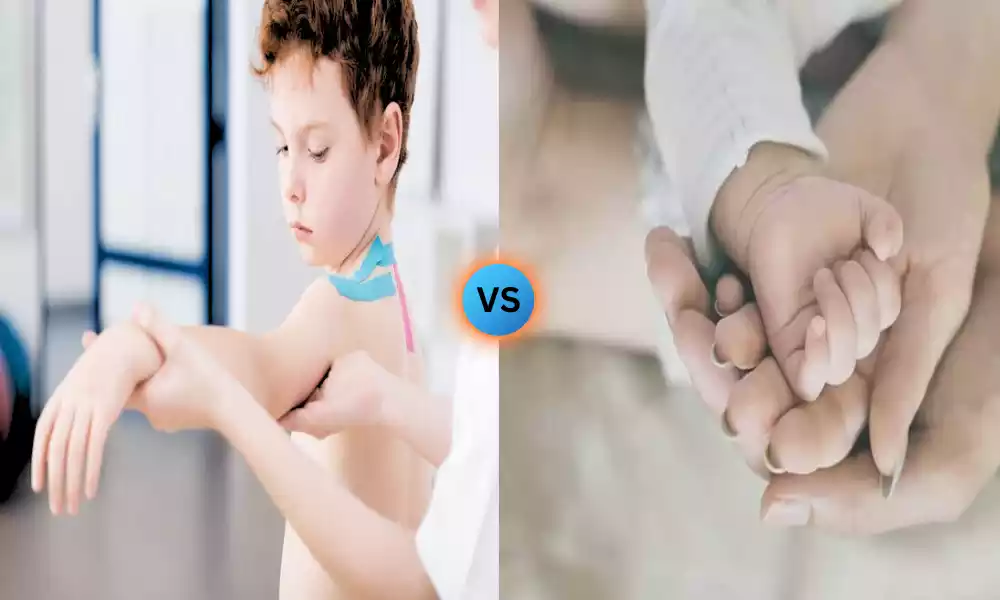Erb’s Palsy and Klumpke’s Palsy Palsy are two distinct neurological conditions that result from damage to the brachial plexus, a network of nerves controlling the arm and hand. Erb’s Palsy primarily affects the upper brachial plexus and typically leads to weakness or paralysis of the shoulder and upper arm muscles.
Klumpke’s Palsy involves the lower brachial plexus and primarily affects the hand and forearm, leading to issues like hand weakness or claw-like deformities. Both conditions can occur during childbirth or due to other traumatic events and require specific diagnosis and treatment approaches. Understanding the differences between Erb’s Palsy and Klumpke’s Palsy is crucial for proper management and care.
What is Erb’s Palsy?
Erb’s Palsy is a neurological condition that results from damage to the upper brachial plexus, a network of nerves in the shoulder and upper arm. It often occurs during childbirth when excessive force or stretching is applied to the baby’s head and neck during delivery. This injury can lead to weakness or paralysis of the muscles in the affected arm, typically characterized by a lack of movement in the shoulder, elbow, and wrist.

Common symptoms include the arm being held close to the body, inability to raise the arm, and a limp or floppy appearance. Erb’s Palsy may require medical evaluation, physical therapy, and in some cases, surgical intervention to improve function and mobility in the affected arm. Early diagnosis and appropriate treatment are crucial for the best possible outcome.
Causes of Erb’s Palsy
Erb’s Palsy is primarily caused by excessive force or stretching of the upper brachial plexus nerves (C5-C6) during childbirth.
Common causes include:
- Shoulder Dystocia: This occurs when a baby’s head passes through the birth canal but their shoulders become stuck behind the mother’s pelvic bone, requiring significant force to deliver the baby.
- Difficult or Prolonged Birth: Long or challenging labor, especially when the baby’s head is delivered but the shoulders are impacted, can increase the risk of nerve injury.
- Breech Birth: Babies born in the breech position (feet or buttocks first) are at a higher risk because of the different delivery dynamics.
- Excessive Traction: Healthcare providers pulling on the baby’s head or neck during delivery can lead to nerve damage.
- Large Birth Weight: Babies with a high birth weight are more susceptible because they may have a greater difficulty passing through the birth canal.
- Maternal Factors: Factors such as gestational diabetes or obesity can increase the risk of Erb’s Palsy in newborns.
These are common causes, Erb’s Palsy can occur due to various childbirth-related factors, and each case may have its unique circumstances. Early diagnosis and appropriate management are essential for the best possible outcome.
Symptoms of Erb’s Palsy
Symptoms of Erb’s Palsy include:
-
- Arm Weakness: Limited or no movement in the affected arm.
- Limp Arm: The arm may hang by the side and appear floppy.
- Inability to Raise Arm: Difficulty in lifting the arm.
- Loss of Sensation: Reduced or absent sensation in the arm.
- Abnormal Muscle Development: Muscle atrophy or underdevelopment in the shoulder, upper arm, and hand.
- Abnormal Reflexes: Altered reflexes in the affected arm.
- Reduced Grip Strength: Difficulty in holding or grasping objects with the hand.
Symptoms can vary in severity, and early diagnosis and intervention are crucial for improving outcomes.
What is Klumpke’s Palsy?
Klumpke’s Palsy, also known as Klumpke’s Paralysis, is a neurological condition resulting from damage to the lower brachial plexus, a network of nerves that control the hand and forearm. It can occur during childbirth or due to traumatic events where the arm is forcibly pulled or stretched. Klumpke’s Palsy typically leads to weakness or paralysis in the hand and forearm muscles.

This condition is often characterized by a claw-like deformity of the hand, where the fingers are flexed and cannot be extended. Other symptoms may include difficulty gripping objects or moving the affected hand and wrist. Treatment for Klumpke’s Palsy may involve medical evaluation, physical therapy, and, in some cases, surgical intervention to restore function and mobility in the affected hand and forearm. Early diagnosis and appropriate intervention are essential for the best possible outcome.
Causes of Klumpke’s Palsy
Klumpke’s Palsy is primarily caused by damage to the lower brachial plexus nerves (C7-C8, T1) and typically occurs due to:
-
- Forceful Pulling: Klumpke’s Palsy often results from forceful pulling of the baby’s arm during childbirth, which can stretch or tear the nerves in the lower brachial plexus.
- Difficult Childbirth: Complicated or prolonged labor, particularly when the baby’s arm is positioned awkwardly during delivery, increases the risk of nerve injury.
- Breech Birth: Babies born in the breech position (feet or buttocks first) are more vulnerable to Klumpke’s Palsy due to the atypical positioning during delivery.
- Maternal Factors: Certain maternal conditions, such as a small pelvis, may contribute to the risk of Klumpke’s Palsy.
Early diagnosis and appropriate medical care are crucial to manage Klumpke’s Palsy effectively and minimize long-term complications.
Symptoms of Klumpke’s Palsy
Symptoms of Klumpke’s Palsy include:
-
- Hand Weakness: Weakness or paralysis in the hand and forearm.
- Claw-Like Hand Deformity: Fingers may be flexed and cannot be extended, resulting in a claw-like appearance.
- Impaired Hand Function: Difficulty gripping objects, using the hand, or performing fine motor tasks.
- Loss of Sensation: Reduced or absent sensation in the hand and forearm.
- Altered Reflexes: Abnormal reflexes in the affected hand.
These symptoms are typically associated with damage to the lower brachial plexus nerves and require early diagnosis and appropriate treatment for the best possible outcome.
Comparison Table of Erb’s Palsy and Klumpke’s Palsy
Here’s a comparison table of Erb’s Palsy and Klumpke’s Palsy:
| Characteristic | Erb’s Palsy | Klumpke’s Palsy |
|---|---|---|
| Location of Brachial Plexus | Upper brachial plexus (C5-C6 nerves) | Lower brachial plexus (C7-C8, T1) |
| Primary Muscle Groups Affected | Shoulder, upper arm | Hand, wrist, and forearm |
| Common Causes | Birth trauma, excessive stretching | Birth trauma, forceful pulling |
| Risk Factors | Large birth weight, difficult birth | Difficult childbirth, breech birth |
| Clinical Presentation | – Limited movement in shoulder, elbow, and wrist
– Weakness or partial paralysis in the affected arm |
– Claw-like hand deformity
– Hand and forearm |
| Diagnosis | Clinical examination, medical imaging (e.g., MRI), electromyogram | Clinical examination, medical imaging (e.g., MRI), electromyogram |
| Treatment Options | – Physical therapy
– Surgery (in severe cases) |
– Physical therapy
– Surgery (rarely) |
| Prognosis | Generally good with early intervention, but outcomes vary | Generally good with early intervention, but outcomes vary |
| Potential Complications | Muscle atrophy, joint contractures | Muscle atrophy, hand deformities |
| Prevention Strategies | Proper obstetric care during childbirth to minimize risk | Proper obstetric care during childbirth to minimize risk |
The outcomes and severity of both Erb’s Palsy and Klumpke’s Palsy can vary widely depending on the extent of nerve damage and the timeliness of intervention. Treatment approaches should always be tailored to the specific needs of the individual patient.
Diagnosis of Erb’s Palsy and Klumpke’s Palsy
The diagnosis of Erb’s Palsy and Klumpke’s Palsy typically involves a combination of medical evaluation, clinical examination, and, in some cases, additional diagnostic tests.
Here’s an overview of the diagnostic process for both conditions:
Diagnosis of Erb’s Palsy:
- Medical History: The healthcare provider will gather information about the baby’s birth, any complications during labor and delivery, and any maternal factors that may be relevant.
- Clinical Examination: A physical examination of the baby will be conducted to assess muscle strength, reflexes, and range of motion in the affected arm.
- Nerve Function Assessment: The healthcare provider will check for sensory and motor deficits in the affected arm to identify nerve damage.
- Medical Imaging: In some cases, medical imaging studies such as Magnetic Resonance Imaging (MRI) or ultrasound may be ordered to visualize the brachial plexus and confirm the location and extent of nerve injury.
Diagnosis of Klumpke’s Palsy:
- Medical History: Similar to Erb’s Palsy, the healthcare provider will gather information about the circumstances of the baby’s birth and any maternal factors that may be relevant.
- Clinical Examination: A physical examination will assess muscle strength, reflexes, and range of motion in the affected hand and forearm.
- Nerve Function Assessment: Sensory and motor deficits in the hand and forearm will be evaluated to identify nerve damage specific to the lower brachial plexus.
- Medical Imaging: Medical imaging studies such as MRI or ultrasound may be used to confirm the location and extent of nerve injury in Klumpke’s Palsy, though these are less common than in Erb’s Palsy.
The diagnostic process is essential to determine the type and severity of the brachial plexus injury and guide appropriate treatment. Early diagnosis is crucial for the best possible outcomes in both Erb’s Palsy and Klumpke’s Palsy.
Treatment Options for Erb’s Palsy and Klumpke’s Palsy
Treatment options for Erb’s Palsy and Klumpke’s Palsy focus on improving function, mobility, and minimizing long-term complications. The choice of treatment depends on the severity of the condition and individual circumstances.
Here are common treatment options for both Erb’s Palsy and Klumpke’s Palsy:
Physical Therapy:
- Erb’s Palsy: Physical therapy is essential to strengthen and rehabilitate the affected arm. Therapists use exercises, stretches, and techniques to improve muscle strength, range of motion, and coordination.
- Klumpke’s Palsy: Physical therapy aims to enhance hand and forearm function, focusing on exercises that improve hand strength, dexterity, and mobility.
Occupational Therapy:
- Erb’s Palsy: Occupational therapists assist in developing fine motor skills and optimizing arm functionality for daily activities.
- Klumpke’s Palsy: Occupational therapy focuses on improving hand and finger dexterity, grip strength, and adaptive techniques for daily living.
Splinting and Bracing:
- Erb’s Palsy: In some cases, splints or braces may be prescribed to support and position the affected arm correctly, preventing contractures and promoting proper alignment.
- Klumpke’s Palsy: Splints or orthotic devices can help maintain optimal hand and wrist positioning to prevent deformities.
Medications:
- Medications are not typically a primary treatment but may be used for pain management or to address specific symptoms as needed.
Surgical Intervention:
- Erb’s Palsy: In severe cases with limited improvement from conservative treatments, surgical options like nerve grafts or nerve transfers may be considered to restore nerve function.
- Klumpke’s Palsy: Surgical intervention is rare for Klumpke’s Palsy but may be considered in unique cases with severe nerve damage.
Assistive Devices:
- Depending on the child’s needs, adaptive tools or equipment may be recommended to enhance independence and functionality.
Supportive Care:
- Emotional and psychological support for both the child and their family is essential. Support groups and counseling can help address the emotional impact of these conditions.
Treatment plans should be individualized, considering the type and extent of nerve damage, the child’s age, and overall health. Early intervention and a multidisciplinary approach involving therapists, pediatricians, and surgeons when necessary can lead to improved outcomes for children with Erb’s Palsy and Klumpke’s Palsy.
Similarities between Erb’s Palsy and Klumpke’s Palsy
While Erb’s Palsy and Klumpke’s Palsy are distinct conditions caused by damage to different parts of the brachial plexus, they do share some similarities:
- Brachial Plexus Injury: Both Erb’s Palsy and Klumpke’s Palsy are brachial plexus injuries. They result from damage to the brachial plexus, a network of nerves that control various functions in the arm.
- Birth-Related Causes: These conditions often occur as a result of childbirth trauma or difficult deliveries. In both cases, excessive force or stretching during birth can lead to nerve damage.
- Neurological Effects: Both conditions result in neurological deficits and motor dysfunction. They can cause muscle weakness, partial paralysis, and loss of movement in affected areas of the arm.
- Medical Evaluation: Diagnosis for both Erb’s Palsy and Klumpke’s Palsy typically involves medical evaluation, clinical examination, and sometimes the use of medical imaging or electromyography to assess nerve damage.
- Physical Therapy: Physical therapy is a common treatment approach for both conditions. It aims to improve muscle strength, range of motion, and functional abilities in the affected limb.
- Surgical Intervention (in some cases): Although less common, both conditions may require surgical intervention in severe cases or when conservative treatments are ineffective.
- Prognosis: The prognosis for both Erb’s Palsy and Klumpke’s Palsy is generally better with early intervention and appropriate treatment. However, outcomes can vary widely depending on the extent of nerve damage and the individual’s response to treatment.
These similarities, Erb’s Palsy and Klumpke’s Palsy are distinct conditions with different clinical presentations, locations of nerve damage within the brachial plexus, and treatment approaches tailored to their specific characteristics.
Coping with Erb’s Palsy or Klumpke’s Palsy
Coping with Erb’s Palsy or Klumpke’s Palsy can be challenging for both the child and their family. These conditions may require ongoing medical care and therapy.
Here are some strategies to help cope with these conditions:
For the Child:
- Supportive Environment: Create a loving and nurturing environment that promotes the child’s self-esteem and confidence. Encourage them to explore their abilities and interests.
- Therapy and Treatment: Ensure the child receives regular therapy and treatment sessions. Consistency and patience are key to making progress.
- Education: Keep the child’s educational needs in mind. Work with teachers and school staff to provide any necessary accommodations or support.
- Encourage Independence: Foster independence by encouraging the child to participate in daily activities to the best of their abilities. This can boost their self-esteem.
- Advocacy: Be an advocate for your child. Ensure they receive the necessary support and accommodations at school and in other environments.
For the Family:
- Education: Learn as much as you can about Erb’s Palsy or Klumpke’s Palsy. Understanding the condition and its treatment options can help you make informed decisions.
- Support Groups: Join support groups for parents and families dealing with similar challenges. Connecting with others who have faced similar situations can provide emotional support and practical advice.
- Professional Guidance: Seek guidance from healthcare professionals, therapists, and specialists who can provide expertise and guidance on managing the condition.
- Emotional Support: Recognize and address your own emotional needs. Coping with a child’s medical condition can be stressful, so don’t hesitate to seek counseling or therapy if needed.
- Routine and Consistency: Establish a routine that includes therapy, medical appointments, and daily care. Consistency can help both the child and the family manage the condition more effectively.
- Celebrate Achievements: Recognize your child’s achievements no matter how small. Doing so will encourage him or her to pursue further successes. Each milestone is a step toward progress.
For Both:
- Open Communication: Encourage open communication within the family. Allow your child to express their feelings and concerns, and be receptive to their needs.
- Focus on Abilities: Emphasize your child’s strengths and abilities rather than dwelling on limitations.
- Set Realistic Goals: Work with healthcare providers to set realistic goals for your child’s progress. Divide them up into manageable steps.
- Take Breaks: Caring for a child with a medical condition can be exhausting. Don’t forget to take breaks and practice self-care to recharge.
- Advocate for Inclusivity: Advocate for inclusivity and awareness in your community and schools to ensure that children with Erb’s Palsy or Klumpke’s Palsy have equal opportunities.
Remember that every child and family’s experience with these conditions is unique. Seek professional guidance and support, and adapt coping strategies to suit your specific circumstances. With patience, love, and support, children with Erb’s Palsy or Klumpke’s Palsy can lead fulfilling lives and achieve their potential.
Conclusion
Erb’s Palsy and Klumpke’s Palsy are challenging neurological conditions that affect different parts of the brachial plexus, often resulting from birth trauma. Early diagnosis and appropriate treatment are crucial for improving outcomes in both conditions. While managing these conditions can be demanding, a supportive and informed approach, involving medical professionals, therapists, and emotional support networks, can significantly enhance the quality of life for children and families dealing with Erb’s Palsy and Klumpke’s Palsy.



